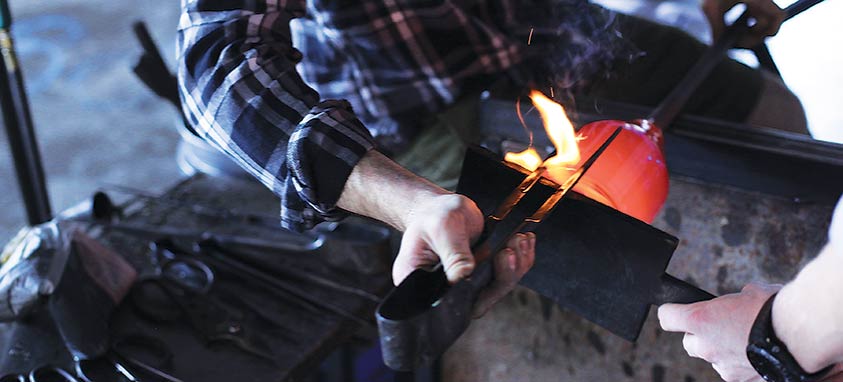Lexington Glassworks, Asheville
North Carolina’s thriving cultural scene
It’s hard to think of a state with more diversity than North Carolina, as seen in its geography, history and culture, including its traditional arts and crafts scene.
On the eastern coast lie the lowlands, where life and local cultures have always been touched by the proximity of the shore and the ocean. There you have beautiful barrier islands including Ocracoke, with timeless, picturesque villages, along with towns such as Wilmington.
A bit inland is the Piedmont, with rolling green hills and the state’s three largest cities—Charlotte, Raleigh-Durham and Greensboro—each with its own distinct history and flavor.
In the west, of course, are the fog-shrouded peaks of the Great Smoky and Blue Ridge mountain ranges, with thundering waterfalls, multicolored ridges stretching out forever in front of you, and an old mountain culture that’s still lovingly nourished. There you’ll find the colorful little city of Asheville, reborn in part because of its vital creative community.
North Carolina’s main cities each boast thriving cultural scenes, not only with modern performing arts facilities, but also with revivals of traditional local arts and crafts, practiced by growing artistic communities infusing new life into old arts. This new creativity is helping to stimulate the meetings business there, as well. Many places where these arts and crafts are practiced or taught have great meeting spaces, and they can help inspire attendees with new ideas, contacts and enthusiasm.
Asheville
 Grovewood Gallery, Asheville
Grovewood Gallery, Asheville
Asheville, sitting in the Blue Ridge Mountains near the magnificent Blue Ridge Parkway, is where funky meets traditional, mountain culture meets avant-garde, and cosmopolitan meets historic. It’s one of the most eclectic cities in America, where warehouses are being repurposed as art studios, a restaurant is made out of shipping containers and old auto shops now house breweries.
Asheville’s creative energy is infectious, and meeting attendees who experience it tend to return home focused and fired up.
Asheville boasts hundreds of studios and art galleries, world-class culinary and craft beer cultures, a thriving live music scene and, of course, awe-inspiring scenery everywhere you turn. There are street performers on most downtown corners, the popular Friday Night Drum Circle, and a year-round calendar of arts and crafts festivals.
 The Omni Grove Park Inn, Asheville
The Omni Grove Park Inn, Asheville
Happily, several meeting hotels have excellent arts and crafts collections. Attendees visiting Biltmore House, America’s largest home and the vision of George W. Vanderbilt, have access to the 250-room French Renaissance chateau that exhibits the Vanderbilt family’s original collection of furnishings, art and antiques. The Inn on Biltmore Estate is a lodging property on the 8,000-acre estate.
The Omni Grove Park Inn is a living gallery, with the magnificent Roycroft antique lighting and furnishings it had when it opened in 1913. The original Craftsman furnishings have been restored to the 142 guest rooms in the Main Inn, as well. The National Arts & Crafts Conference and Antiques Show was just staged at the Grove Park Inn in February for the 30th consecutive year.
 Asheville Art Studio Tours (photo by celiatabitha.com)
Asheville Art Studio Tours (photo by celiatabitha.com)
Local artisans create beautiful, one-of-a-kind art at Lexington Glassworks, where groups can enjoy glass-blowing demonstrations and a meeting space large enough for 110 guests. Asheville Art Studio Tours takes small groups on walking tours of the River Arts District, and its newest offering, Experience Tour, allows attendees the opportunity to try their hands at throwing pottery and blowing glass.
Grovewood Gallery, located near the Omni Grove Park Inn, was the site of a homespun-fabric company for many years. This year, it will be offering historic tours of the factory buildings and showing handcrafted fabrics from those days.
Gwynne Rukenbrod-Smith knows more about crafts than most people—she’s executive director of the Eugene, Oregon-based Society of North American Goldsmiths, a membership organization supporting jewelry artists and metalsmiths. She says no city in America has more creative energy than Asheville.
“We had our annual conference in Asheville last May,” Rukenbrod-Smith says. “We had 500 attendees—all of them, of course, involved in the creative arts—and our post-meeting surveys were off the charts. One of our venues was the Center for Craft, Creativity & Design and another one was a music venue called The Orange Peel. We also did an exhibition crawl one night, where the galleries stayed open late and the artists talked about their trades. If you’re looking for a boost in creativity from your people, there’s no better place than Asheville!”
Charlotte
 Atrium at Levine Museum of the New South, Charlotte (photo by Lunahzon Photography)
Atrium at Levine Museum of the New South, Charlotte (photo by Lunahzon Photography)
Anyone who’s seen the Charlotte skyline lately can testify that it is now a major American metropolis.
It’s major in the arts world, as well. The region is home to talented craftspeople and artisans who have molded the city’s cultural footprint through quilting, pottery, painting, woodwork and more. Homegrown artwork doesn’t just fill the galleries: It also adorns the walls of eateries and the shelves of shops, where it’s often available for purchase. Traditional music and dance are still valued here, too, and celebrated at dozens of annual events.
The colorful NoDa neighborhood boasts a cluster of former mill villages reborn as an eclectic arts district, known for events such as monthly gallery crawls highlighting local talents. Charlotte-based sculptor Paul Sires and his wife, painter Ruth Ava Lyons, initiated this transformation in the ’80s. Neighborhoods that were once full of derelict mills are now morphing into fascinating arts districts, among them South End and the Second Ward in Uptown (which is actually downtown).
In addition, groups such as Charlotte Quilters’ Guild, Charlotte Folk Society and Modern Craft Collective are dedicated to preserving North Carolina’s rich crafts tradition.
A key moment in Charlotte’s artistic transformation occurred with the opening of Mint Museum Randolph in 1936, which was North Carolina’s first arts museum. It’s housed in the city’s original United States Mint building in the Eastover neighborhood. This facility can hold 600 people for receptions and 215 (in two rooms) for dinner. A second location, Mint Museum Uptown (see sidebar), houses the renowned Mint Museum of Craft & Design collection. It has a 240-seat auditorium, 145,000 sq. ft. of event space and can house 415 attendees for dinner in two separate rooms.
In a city filled with great museums, Levine Museum of the New South is one of the best. This extraordinary facility brings to life the North Carolina Piedmont after the Civil War, and exhibits include historical arts, crafts and music. It also brings life to meetings and events with a variety of interesting spaces, and the full museum can accommodate up to 600 attendees.
Inside Levine Museum is Harvey B. Gantt Center for African-American Art & Culture, with three levels of event space. There’s a rooftop pavilion with stunning views of Uptown.
 7th Street Public Market, Charlotte (photo by Manny Handsome via charlottesgotalot.com)
7th Street Public Market, Charlotte (photo by Manny Handsome via charlottesgotalot.com)
Charlotte nurtures its less-formal artistic gathering places, as well. The 7th Street Public Market is filled with eateries and craft bazaars by day and has meeting and event space by night.
Susan Perry, executive director of the Atlanta-based organization Southeast Museums Conference (SEMC), held the association’s annual conference in Charlotte last October.
“We had over 600 attendees, which was a new record for us,” she says. “The fact that Charlotte’s a great arts-and-crafts town had a lot to do with that. We visited the African-American Museum, the Levine, McCall Center for the Arts and several craft museums, among them the Mint, with great collections of pottery, furniture and quilts. We also visited the Penland School of Crafts, where we watched artists create glassworks, ceramics, weavings and metal art. Our people would go back to Charlotte in a heartbeat!”
Greensboro
 Elsewhere, Greensboro
Elsewhere, Greensboro
This central North Carolina city, founded in 1808, has a population exceeding 250,000. Known mostly for business and industry, it’s also become, in recent years, a hotbed of artistic creativity.
One of the biggest names in the local arts community is ArtsGreensboro, which supports more than 50 arts organizations and projects each year. This organization has created numerous arts cooperatives and festivals, and supports local events including I Heart Arts Month.
The southside area of downtown has excellent galleries and craft studios. Artmongerz features crafts in a variety of media. Elements Gallery is a co-op of local sculpture, pottery, glass, wood-carving, furniture and fiber artists. Ambleside Gallery features interesting etchings, lithography and woodcuts from around the world.
GreenHill Center for North Carolina Art stages create-your-own-crafts workshops in traditional crafts, such as weaving, and is attached to several crafts and art galleries. The entire 7,000 sq. ft. is rentable, as are each of the surrounding studios and galleries.
Elsewhere is a “living” museum in a 1930s three-story building that was once a thrift store. The former owners of the property sold it with the provision that nothing from the thrift store would be thrown out, and succeeding owners have kept that promise. If it’s a collectible Americana piece, you’ll find it here, along with some great memories. The three floors also offer a mix-and-match variety of spaces for groups.
 Van Dyke Performance Space
Van Dyke Performance Space
Greensboro Cultural Center provides studio, gallery, classroom and meeting spaces for 15 arts organizations. Van Dyke Performance Space seats up to 500, and there’s also a variety of smaller rental spaces. Located inside the center, Arts Greensboro offers the Greensboro Depot, with seating for 80; the boardroom has room for 50 seats; and the orientation room provides seating for 40.
If you like to tie your meetings in with local events, Greensboro’s got plenty of arts and crafts festivals, among them 17 Days Art & Culture Festival, usually in September, with more than 100 events across the city. Greensboro is also hosting National Folk Festival for the third consecutive year. This September, downtown will turn into a collage of color and energy, with seven stages and 300 artists demonstrating their music, crafts and art.
“Greensboro is a vibrant city with a rich tradition of craft,” says Toni Tronu, registrar at GreenHill Center for North Carolina Art. “Creativity is literally in the air here, as evidenced by the large Janet Echelman public art piece suspended over LeBauer Park. Arts organizations here benefit from a very supportive population that shows up to participate, both physically and fiscally. And that’s one of the reasons I moved here!”
Raleigh
 The Pit Authentic Barbecue, Raleigh (photo by Scott LeVoyer)
The Pit Authentic Barbecue, Raleigh (photo by Scott LeVoyer)
Raleigh’s known for being one of the world’s great technology centers, as it anchors the famous Research Triangle, along with Durham and Chapel Hill. It’s also a center of education, home to North Carolina State University and six other colleges. Duke University is in Durham, and the University of North Carolina is in Chapel Hill.
This is a city with a soul, combining technology with education, historic preservation efforts, very high quality-of-life rankings and natural beauty. It’s also a city with entrepreneurial locals who are responsible for its increasingly strong cultural heartbeat, expressed in its museums, arts, live music and a new emphasis on old art forms.
In fact, this city is a leader in the revival of traditional North Carolina arts.
That isn’t a new role for Raleigh, however: It’s always been a leader in the arts. In fact, its North Carolina Museum of Art was the first major museum in the country to be formed and funded by state legislation. This venue offers eight different indoor and outdoor meeting spaces, ranging from an education garden holding 125 to the main hall, holding 275.
 Artistic Abandon, Raleigh
Artistic Abandon, Raleigh
The city’s old Warehouse District, filled with red-brick warehouses, has transformed into an intriguing mix of restaurants, specialty shops and antique stores. You’ll find the 22,300-square-foot Contemporary Art Museum, some of which can be used for meetings. Nearby is another legendary spot: The Pit Authentic Barbecue restaurant.
Moore Square, in the central business district, is a park listed on the National Register of Historic Places, and City Market, a retail and restaurant center on cobblestone streets, is on the park’s edge. This district also has a growing number of art galleries, anchored by Artspace North Carolina, a 30,000-square-foot historic building with 30 studios, three exhibition galleries and space for 500 attendees if the entire space is rented, along with smaller meeting and event rooms.
Traditional arts are morphing into a modern movement at Crafts Center at North Carolina State University. In this facility, where imagination runs wild, they teach about things you never thought you would hear of again: clay trinket boxes, wire-wrapped jewlery, pendants, fiber, art-on-paper, bracelet-making and painting on leather. Classes and workshops here will spark creativity in your attendees.
If you’d like to help your attendees become Picasso for a night, Artistic Abandon is the place to do it. You can stage team-building painting lessons, complete with wine if you desire.
In the nearby town of Cary, the Cary Arts Center also brings new life to old crafts. There’s a 437-seat theater for meetings, and smaller spaces such as conference rooms and studios. The center offers classes in areas such as ceramic arts, and interesting “open studios” in disciplines such as glass and metals.
Steve Winston has written or contributed to 16 books, and his magazine articles have appeared in major media around the world.
Charlotte’s Mint
 Mint Museum Uptown (photo by Jeff Clare)
Mint Museum Uptown (photo by Jeff Clare)
You’d be hard-pressed to find a better venue for your event than Mint Museum Uptown in Charlotte. The five-story, 145,000-square-foot facility is bursting with inspiration.
Machado and Silvetti Associates—the designer masterminds behind the 2007 Getty Villa redesign in Los Angeles and the 2011 Honan-Allston branch of the Boston Public Library—completed this architectural masterpiece in 2010 in an effort to bring Mint Museum of Art and Mint Museum of Craft and Design under one roof.
Mint Museum Uptown (pictured) has five different spaces that can accommodate groups big and small, from 10 in the conference room to 400 in Robert Haywood Morrison Atrium or the front lawn (yes, they do tented events, too).
But it also is smack-dab in the middle of Levine Center for the Arts, a cultural campus in the heart of the city. Bechtler Museum of Modern Art is just across the street, as is Knight Theater, the 1,192-seat theater that is home to Charlotte’s Broadway scene. (Check out the genre-bending show Hedwig and the Angry Inch come April.)
The eastern kitty corner of the block holds Harvey B. Gantt Center for African-American Arts and Culture. It’s right behind the Bechtler is Duke Energy Center and across the block from New Gallery of Modern Art it. No matter where you look, there’s a top-notch museum or gallery.
But Mint Uptown is the most inviting to the public, with its massive concrete staircase leading to the entrance, akin to the famed steps of New York City’s Metropolitan Museum of Art. Galleries for the art museum, and craft and design museum are on the third and fourth floors, but the rest of the building is dedicated to meeting spaces. It was built to serve as a community hub, and your group is surely to be inspired.
Major Meeting Venues
Asheville
Crowne Plaza Resort Asheville
Located a few minutes drive from downtown; fitness center; full-service Adelaide Spa; business center; Overlook Restaurant serves healthy Southern dishes; 272 guest rooms; 34,000 sq. ft. of meeting space.
Inn on Biltmore Estate
Located on the Biltmore Estate, home to Biltmore House, America’s largest home; Antler Hill Village & Winery; seven restaurants; 8,000 acres of outdoor recreation options; 210 guest rooms; 5,000 sq. ft. of meeting space.
Renaissance Asheville Hotel
Beautifully designed modern hotel in downtown Asheville; free Wi-Fi; indoor pool; The Writer’s Bistro specializes in farm-to-table cuisine; 24/7 fitness center; 277 guest rooms; 21,000 sq. ft. of meeting space.
The Omni Grove Park Inn

One of the greatest hotels on the East Coast; 10 restaurants and bars; golf course; 43,000-square-foot subterranean spa; two retail promenades; 513 guest rooms; 55,000 sq. ft. of meeting space.
U.S. Cellular Center
Century-long history; modern amenities; arena holds 7,200, auditorium 2,431; exhibit hall can accommodate 2,000; banquet hall for 500; 185,000 sq. ft. of meeting space.
Charlotte
Charlotte Convention Center
Across the street from the Westin Charlotte; connected via over-street walkway to NASCAR Hall of Fame; close to museums and nightlife in the EpiCentre district; 550,000 sq. ft. of meeting space.
Le Meridien Charlotte
Near museums and arts enterprises; three restaurants; rooftop bar; outdoor venues for meetings and events; 300 guest rooms; 65,000 sq. ft. of meeting space (shared with Sheraton Charlotte Hotel).
Mint Museum Uptown
Located in Levine Center for the Arts complex; impressive decorative arts in wide variety of media; 145,000 sq. ft. of meeting space.
Renaissance Charlotte Suites Hotel
Close to the airport; two-room suites; fitness center; indoor pool; distinctive dining at Clock Tower Restaurant; modern meeting spaces; 273 guest rooms; 22,849 sq. ft. of meeting space.
The Ballantyne Hotel, Charlotte
208 guest rooms in main hotel, 35 in The Lodge and four in The Cottage; championship golf course; The Spa at Ballantyne; four excellent restaurants and bars; 40,000 sq. ft. of meeting space in lodge, 30,000 in main hotel.
The Westin Charlotte

Next door to Charlotte Convention Center, NASCAR Hall of Fame; fitness center; business center; workspaces; two restaurants and bar; 700 guest rooms; 44,000 sq. ft. of meeting space.
Greensboro
Grandover Resort
A luxurious, prominent landmark; two championship golf courses; full-service spa; elegant continental dining at Di Valetta Restaurant; 247 guest rooms; 45,000 sq. ft. of meeting space.
Greensboro Cultural Center
Meet among innovative artworks; four stories of galleries, studios, classrooms and rehearsal spaces; 7,500-square-foot theater; 1,600 sq. ft. for meetings.
Greensboro-High Point Marriott Airport
Brush Creek Grille; 24/7 fitness center; Saura Gardens has excellent outdoor space; 300 guest rooms; 11,048 sq. ft. of meeting space.
Greensboro Marriott Downtown
Convenient to restaurants, museums, shopping; fitness center and indoor pool; Bistro serves upscale American cuisine; modern meeting spaces; 281 guest rooms; 28,517 sq. ft. of meeting space.
Sheraton Greensboro Hotel at Four Seasons

Each guest room has workspace; six restaurants and bars; shopping just outside; fitness center; indoor and outdoor pools; 985 guest rooms; hotel incorporates Koury Convention Center, with 250,000 sq. ft.
Raleigh
Artspace
Attractive 30,000-square-foot space; diverse venue where artists display, regular folks create and attendees meet; Gallery 2 holds up to 300 for receptions or buffets; lobby accommodates 100; entire building can also be rented.
Embassy Suites Raleigh-Durham/Research Triangle
Close to Raleigh Triangle Park, airport and attractions; indoor pool; fitness center; Bistro in the Park Restaurant in an open-air atrium; tennis; basketball courts; 273 guest rooms; 29,000 sq. ft. of meeting space.
Hilton North Raleigh/Midtown
Convenient to Historic District; free airport shuttle; Lofton’s and Skybox Grill restaurants; fitness center; indoor pool; hot tub; business center; 333 guest rooms; 30,000 sq. ft. of meeting space.
Raleigh Convention Center
Architecturally striking building in the heart of downtown; exterior design lets in a lot of natural light; convenient to hotels and theaters; 500,000 sq. ft. of meeting space.
Raleigh Marriott City Center
Connected to Raleigh Convention Center; indoor pool; fitness center; Rye Bar and Southern Kitchen serves regional specialties; meeting spaces are airy and modern; 400 guest rooms; 15,119 sq. ft. of meeting space.
Raleigh Marriott Crabtree Valley
Close to PNC Arena, downtown restaurants, North Carolina State University; Braise Contemporary Southern Restaurant offers regional specialties; meeting spaces have natural light; 374 guest rooms; 22,181 sq. ft. of meeting space.




